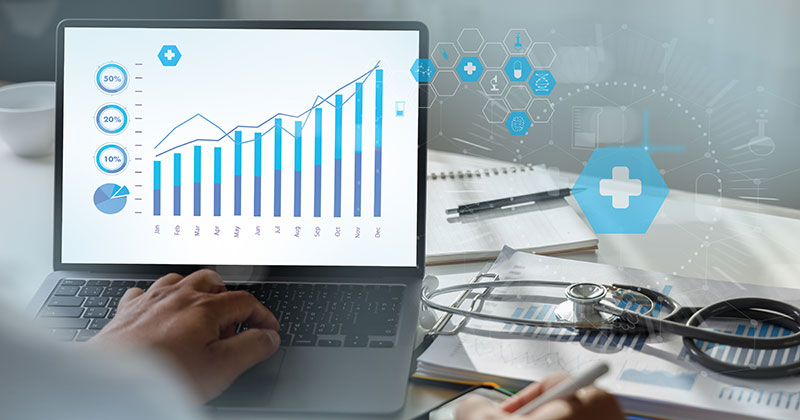Using Technology for Streamlined Revenue Cycle Management - A Guide for Healthcare Practices

Running a healthcare practice means dealing with a lot of paperwork and billing challenges.
But with revenue cycle management technology, you can make these tasks easier. You can improve the patient experience and prepare for the future of healthcare. This technology helps you work smarter, not harder. It ensures your practice runs smoothly and your patients are happy.
This article will discuss why managing your revenue cycle is so important and how technology can help. You’ll learn about the benefits of using the latest technology in your practice and see what innovations are available.
Finally, we’ll share advice on how to choose the right technology for your team.
Importance of Revenue Cycle Management in Healthcare Practices
Revenue cycle management (RCM) is critical in healthcare. It ensures providers are compensated for their services efficiently and accurately.
RELATED ARTICLE: What Is Revenue Cycle Management? A Comprehensive Guide
It includes all steps leading to payment, including:
- Charge Capture: Recording the services provided to patients
- Claim Submission: Sending claims to insurance companies for payment
- Coding: Using standardized codes to identify procedures and diagnoses
- Patient Collections: Gathering payments from patients
- Preregistration: Collecting patient information before their visit
- Registration: Documenting patient information at the time of their visit
- Remittance Processing: Handling payments from payers
- Third-Party Follow-Up: Dealing with insurance companies for payment
- Utilization Review: Ensuring the necessary medical procedures are provided
RCM links the business and clinical sides of healthcare.
It combines administrative data like the patient’s name and insurance details with treatment and medical history. This connection is vital for effective communication with health insurance companies.
The consequences of poor RCM are far-reaching. They affect more than just a healthcare practice’s finances.
Inefficient RCM leads to late payments and more administrative work. This can cause cash flow issues. Practices might have to reduce services or delay buying new technology.
Staff often get overwhelmed with billing problems. This takes their focus away from caring for patients. As a result, the quality of care might drop.
Patient satisfaction could also decrease due to longer wait times and less attention to their needs.
In contrast, optimized RCM strengthens financial health and operations. Here’s why this efficiency matters:
- A well-run RCM system reduces the gap between patient care and payment. It enhances cash flow.
- RCM integrates with electronic health records and medical billing systems. This promotes a seamless patient journey.
- Starting with preregistration, the process collects essential information early. This reduces administrative rework.
Revenue cycle management technology plays a central role in achieving these outcomes.

Benefits of Revenue Cycle Management Technology
RCM technology improves healthcare practice operations, cash flow, and patient experiences.
FROM ONE OF OUR PARTNERS: 5 Ways to Optimize Revenue Cycle Management
Let’s take a look at some of the top benefits:
Automated Billing Processes
Automation reduces manual errors and speeds up billing. This leads to quicker reimbursements and better cash flow.
Automated billing allows staff to focus on patient care, enhancing the patient experience
Integration with Electronic Health Records (EHRs)
RCM technology and EHR systems integration ensures accurate billing.
It captures all chargeable services from the EHR. This guarantees that providers are appropriately compensated.
Operations become more efficient and, therefore, more profitable.
Improved Claim Accuracy
RCM technology prompts staff to enter necessary information for claims. This reduces claim revisions and denials.
Enhanced Revenue Collection Efficiency
RCM technology makes it easier and faster for healthcare practices to collect payments. This results in quicker access to funds.
A steady cash flow is essential. It helps the practice pay its bills on time and invest in necessary resources.
Financial stability is the foundation of a successful healthcare practice.
Insight Into Denied Claims
RCM technology offers insights into denied claims. Practices can quickly fix issues and avoid repeat errors.
Addressing denied claim causes improves operational efficiency and financial health.
Access to Advanced Features
Modern RCM systems incorporate data analytics. Users can access dashboards to set and monitor revenue goals.
This capability allows practices to identify opportunities for revenue cycle improvement and make data-driven decisions.
FROM ONE OF OUR PARTNERS: Five Things to Know About Revenue Cycle Management (RCM)
Innovative Trends in Revenue Cycle Management Technology
RCM is evolving fast.
Research Nester says the RCM market will grow from $46 billion today to $215 billion by 2035. That’s a yearly growth rate of 13.6%.
Since the pandemic, spending on improving the whole revenue cycle is up by 17%. This trend is likely to keep going until at least 2028.
RCM is about more than just billing and codes. It’s about using innovative technology to understand patients better, make healthcare more efficient, and save money.
Here are some of the latest innovations and trends in RCM technology:

Artificial Intelligence (AI)
AI simplifies healthcare management by handling routine tasks.
It updates patient records, schedules appointments, and processes bills automatically. This lets administrative staff focus on more complex tasks and reduces errors.
AI helps to identify missed charges or underbilling by analyzing billing data. For example, it might find that some procedures were consistently under-coded, resulting in lost revenue.
AI flags these issues. Practices can then adjust billing and recover income.
When reviewing contracts, AI can spot less favorable terms. It suggests better terms for renegotiation with insurance companies. This increases reimbursement rates for healthcare providers.
Patients also benefit from AI. They receive quicker services and accurate cost estimates.
Additionally, AI predicts busy times, allowing practices to staff accordingly.
Big Data and Predictive Analytics
Big data gives healthcare providers detailed insights into their patients. It allows them to analyze patient histories, treatment outcomes, and service use patterns.
This way, providers can identify high-demand and profitable services.
For instance, a clinic might find its diabetes care program is both popular and effective. This suggests a good area for expansion.
Data analytics can also be used to catch inefficiencies.
It might show long wait times for radiology because of old scheduling methods. Or it could find billing errors with lab tests, leading to claim rejections. These issues waste time and delay income.
By tackling these specific problems, practices can cut wait times and fix billing issues.
These changes improve the patient experience and streamline operations, leading to increased revenue.
Telehealth Integration
As more people use telehealth, integrating it with RCM technology becomes essential.
RCM simplifies the billing for online medical services. It allows healthcare providers to charge correctly and quickly for virtual visits.
Fast-tracking billing protects cash flow whether the service provided was in-person or virtually. In addition, patients who use telehealth are satisfied with their experience.
Cognitive Computing
Cognitive computing is a technology that mimics how the human brain works. It uses data and artificial intelligence to solve problems, make decisions, and improve processes.
Cognitive computing helps make sure medical codes are correct for each patient. This reduces mistakes and makes the billing process faster and more accurate.
Technology Supporting Value-Based Care
The healthcare industry is shifting to value-based care (VBC).
McKinsey & Company predicts VBC organizations in the U.S. could double in five years, growing by 15% yearly.
Saving money is a crucial component of VBC. That’s where RCM technology comes in.
RCM empowers providers transitioning to VBC to fix issues like insurance checks or patient cost estimates. They can also save money by optimizing contract management and ensuring all charges are captured.
Moreover, providers joining Accountable Care Organizations (ACOs) must show they’re saving money. RCM can track these efforts.
FROM ONE OF OUR PARTNERS: Improving Patient Interactions with Revenue Cycle Technology

Getting Started: 5 Tips to Choose the Best RCM Solution for Your Practice
Selecting the right RCM technology for your healthcare practice is key to better billing management, cash flow, and patient satisfaction.
Here are five practical tips to guide your choice:
1. Assess the Cost
Consider the total cost of an RCM solution. This includes:
- Initial setup fees
- Monthly or annual subscription
- Costs for additional features or services
Compare the pricing against your budget and the expected return on investment (ROI).
Look for a solution that offers transparent pricing without hidden fees.
2. Check the Quality of Customer Support
Good customer support is crucial for RCM. It ensures any issues you face can be quickly resolved. Access to fast and reliable help minimizes disruptions to your billing and revenue processes.
Your RCM provider should offer comprehensive training for your staff. They should be available to help with any issues that arise, 24/7.
Check their support policies and read reviews to learn about other users’ experiences.
3. Ensure Integration with Existing Systems
The best RCM solution should integrate with your EHR system and other software.
Seamless integration means less disruption to your operations. It allows for more accurate data sharing and processing.
Ask providers about their experience integrating their solution into practices similar to yours.
4. Evaluate the Ease of Use
Your staff will use the RCM software daily. If it’s too complicated, it could slow down your processes, discourage adoption, and lead to errors.
Moreover, complexity can prevent your practice from getting the most out of your investment.
For example, you might be paying for great features. But if these features are hidden behind confusing interfaces, they won’t be used.
This is a waste of money—and potential.
Look for a solution with a straightforward interface and intuitive navigation. Consider requesting a demo or a trial period to test the software’s usability.
5. Review Compliance and Security Features
Compliance with healthcare regulations and data security is non-negotiable. Ensure the RCM solution complies with HIPAA and other relevant regulations.
Look for robust security features to protect patient data. Ask about the provider’s security processes and any history of data breaches.